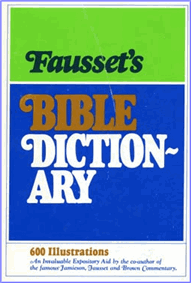Fausset's Bible Dictionary
A B C D E F G H I J K L M N O P Q R S T U V W X Y Z
Eagle
Nesher. Leviticus 11:13. The golden eagle (W. Drake). The griffon vulture; the Arab nisr is plainly the Hebrew nesher. In Micah 1:16, "make thee bald (shaving the head betokening mourning) ... enlarge thy baldness as the nesher," the griffon vulture must be meant; for it is "bald," which the eagle is not. "A majestic and royal bird, the largest and most powerful seen in Israel, far surpassing the eagle in size and power" (Tristram). The Egyptians ranked it as first among birds. The da'ah (Leviticus 11:14) is not "the vulture" but the black kite. The Hebrew qaarach is to make bald the back of the head, very applicable to the griffon vulture's head and neck, which are destitute of true feathers. The golden eagle; the spotted, common in the rocky regions; the imperial; and the Circaeros gallicus (short-toed eagle), living on reptiles only: Israel Exploration Quarterly Statement, October, 1876), are all found in Israel.
Its swift flight is alluded to, and rapacious cruelty, representing prophetically (Habakkuk 1:8; Jeremiah 4:13) the Chaldean, and ultimately, the Roman, invaders of Israel (Deuteronomy 28:49; Ezekiel 17:3-7). Compare Josephus, B. J., 6. Its soaring high and making its nest in the inaccessible rock, also its wonderful far-sightedness and strength (Job 39:27-30). Psalm 103:5 says: "thy youth is renewed like the eagle's"; not as if the eagle renewed its youth in old age, but by the Lord's goodness "thy youth is renewed" so as to be as vigorous as the eagle. The eagle's vigor and longevity are illustrated by the Greek proverb, "the eagle's old age is as good as the lark's youth." Its preying on decomposing carcass symbolizes the divine retributive principle that, where corruption is, there vengeance shall follow. "Wheresoever the carcass is, there will the eagles be gathered together," quoted by our Lord from Job 39:30; Matthew 24:28 -the vulture chiefly feeds on carcass.
The eagle's forcibly training its young to fly pictures the Lord's power, combined with parental tenderness, in training and tending His people (Deuteronomy 32:11; Exodus 19:4). In the law the fostering mother is the eagle, God manifesting His power and sternness mingled with tenderness in bringing His people out of Egypt with a mighty hand and outstretched arm; in the gospel the fostering mother is the hen (Matthew 23:37), Christ coming in grace, humility, and obedience unto death (Bochart). Subsequently, Christ rescues His people "from the face of the serpent" by giving His church the "two wings of a great eagle" (Revelation 12:14).
The eagle "hovers over her young" in teaching them their first flight, ready in a moment to save them when in danger of falling on the rocks below. Compare Isaiah 31:5. God stirred up Israel from the foul nest of Egypt, which of their own accord they would have never left, so satisfied were they with its fleshpots in spite of its corruptions. The "stirring up the nest" spiritually corresponds to the first awakening of the soul; the "fluttering over her young" to the brooding of the Holy Spirit over the awakened soul; the "taking and bearing on her wings" to His continuous teaching and guardian care. The eagle assists the young one's first effort by flying under to sustain it for a moment and encourage its efforts.
So the Spirit cooperates with us, after He has first given us the good will (Philemon 2:12-13). The eagle rouses from the nest, the hen gathers to herself; so the law and the gospel respectively. The Persians under Cyrus had a golden eagle on a spear as their standard (Isaiah 46:11). The eagle is represented in Assyrian sculptures as accompanying their armies; Nisroch, their god, had an eagle's head. The Romans had the eagle standard, hence, the appropriateness of their being compared to an eagle (Deuteronomy 28:49).
Bibliography Information
Fausset, Andrew Robert M.A., D.D., "Definition for 'eagle' Fausset's Bible Dictionary".
bible-history.com - Fausset's; 1878.
Copyright Information
© Fausset's Bible Dictionary
Fausset's Bible Dictionary Home
Bible History Online Home
Bible Encyclopedia (ISBE)
Online Bible (KJV)
Naves Topical Bible
Smith's Bible Dictionary
Easton's Bible Dictionary
Schaff's Bible Dictionary
Fausset's Bible Dictionary
Matthew Henry Bible Commentary
Hitchcock's Bible Dictionary

Dr. A.R. Fausset
Popular and Trending:
Meaning and definition of fasting, what is fasting in the bible, fasting definition, why should I fast, the power of prayer and fasting, Location of Galilee, where was galilee in the bible?, fasting definition, Galilee region, cities of Galilee, Sea of Galilee, Definition of biblical fire, what is fire in the bible?, fire and brimstone, fire meaning, baking bread with fire, Definition of the biblical firmament in Genesis, what is the firmament in the bible?, was the firmament the third heaven, firmament meaning, did the firmament bring the flood of Noah?.
